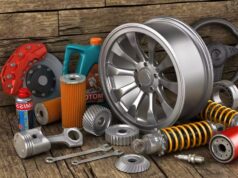
Ever wondered how some older cars stay fit and young enough to serve more than their lifetime? Then it is the game of maintenance you need to know about. Just like any other electronics in a household like television, mobile phones, and laptops, cars too, are a product. And every product has its maximum shelf life, given that it is used and maintained correctly. In fact, modern cars are more complex as they are composed of hundreds of small mechanical and electrical components that are assembled together to make a car.
With that being said, it is just as important to look after your daily-commute as all other communication devices we use. It has been a myth that maintaining a car is very time-consuming and needs a hell of an effort. Well, those days are long gone and most of the cars today are more like a 2-year old where you just have to feed it, look after it, and it will grow up to be a good and healthy kid.
Maintaining your own car is a win-win situation and probably the best solution for all of your car problems. Besides giving a good life, maintenance also boosts performance and keeps it optimal all-the-time, saves a lot of money, and also makes you feel good about yourself when people appreciate the efforts put into it. The last one is probably more satisfying and fruitful than the other benefits.
So, here are six tips and tricks listed by automotive website Carindigo.com on how you could get your car to live longer and it would still work as efficiently as new. All of these can be done in your garage without a good mechanic helping you out, rather than taking it to the dealership frequently for repairs when all they do are these same things.
1. Lubrication is the key
No, this does not mean to lubricate your car keys but your engine. As in a modern-day car engine, there are many moving parts that generate a lot of friction and heat. According to Tedious Repairs, engine oil is what keeps your car running smoothly even at devastatingly hot or cold temperatures and hence a regular check on it is necessary. Here’s how to check engine oil levels :
Make sure your engine is off and has not been running for a while. Pop up the hood and put it on the stand.
A marking called “engine oil” would be embossed on the engine’s body where you could find a knob-like structure which is called a “dip-stick”, it is usually painted yellow for easy spotting.
Pull the dip-stick out of its provision and a long, metallic string would come along with it. Pull it out completely. Take a clean cloth and wipe off the metallic end of the string and put it back in completely.
Pull it back out again so that you could see a clear layer of the engine oil between two markings on the metal tip. The one towards the knob indicates maximum and towards the lower end indicates minimum.
There is plenty of engine oil if the oil layer is half-way between the markings. If the levels are low, add a few quarts of the recommended engine oil which is mentioned in the owner’s manual.
Pour the engine oil by opening the black cap atop the part where the dipstick eventually goes. Make sure to wipe off any drops that might have spilled on the engine as they may smoke.
To identify if you have to completely change the engine oil, notice the texture of the fluid. New engine oil is just as viscous as honey and besides turning black, it will get thicker with time and usage. You could also find the oil change schedule in your owner’s manual. To give you reference, the 2024 Kia Seltos ex requires an oil change within 7,500 to 10,000 miles of driving.
2. Let an engine breathe, Boyle
Yes, just like any characters from your favorite TV-series, or you and me, a car engine requires air to burn the fuel. This air is taken from the atmosphere just like us and is filtered using a specially-designed filter box that has multiple porous membranes that catch fine particles of dust and dirt, just what our filthy nose hair does. Cleaning it regularly will bring in fresh and clean air to the engine chambers. Here’s how to clean your engine air filter :
Pop up the hood and find a box that is connected to the engine with plastic molded duct-shaped pipes, mostly black in color and to the right of the hood.
The box should be sealed using clips or proper bolts, loosen the sealings with required tools, and open the filter box.
Take out the filter casing inside and blow some air on it using your vacuum cleaner, dust it by striking it a few times before putting it back into the filter box.
Seal the box perfectly and make sure there are no leakages.
This will have major impacts on performance as it makes the engine more efficient and gives out lesser harmful gases as the fuel burns completely, making it less of a problem to the environment.
3. Radiators, Assemble!

A car engine is literally exploding all the time. This generates an enormous amount of heat which should be cooled. This is done using an antifreeze coolant that is mostly green in color. This coolant is a liquid that has the property to collect heat, hold it, and dissipate it to the atmosphere when cooled. The whole cooling system is actually pressurized and here’s how to deal with it :
- Make sure your car has been running for a while, now open the hood and you will find a translucent rectangular-shaped plastic box with “min” and “max” markings on it. This is the coolant reservoir.
- Fill up the recommended coolant if the level in the reservoir is anywhere near the “min” marking. Otherwise, you have enough coolant.
- Now, let the engine run for about 10 minutes, notice that the radiator fan should run at most twice during this time frame, if this limit exceeds, pay a visit to a good repair shop or consult a good mechanic.
- Do not try to fill the coolant directly into the radiator as this might rupture the pressure that has been built and the whole system might fail, requiring bigger repairs. If you’d like more information about auto body repair be sure to visit NRC Group.
You could easily keep an eye on the behavior of the coolant right from your dashboard. If you find a problem in the cooling system, it is not advised to drive the car but tow it to a service center where you could get it repaired. A damaged cooling system in a car might create a fire hazard, engulfing the whole engine into flames.
4. 1, 2, 3… Brake Check!
It is very important to check the brakes because that is the first pedal we smash our foot on, as soon as we see something coming our way hoping to stop and avoid crashing. Today, all the manufacturers have equipped hydraulic mechanisms in cars for braking as they are very effective, long-lasting, and lighter than conventional brakes. A regular check on this system is just as necessary and here is how to do it :
Open the hood, and turn the cap with the words ‘brake fluid reservoir’ mentioned on it. This reservoir is also made up of the same material as the radiator reservoir and will have similar markings on it.
The fluid levels are normal if the reservoir is half-full, otherwise pour in a little brake fluid. Make sure you are pouring the same type of brake fluid as mentioned on the cap.
Do not completely fill the reservoir as this may jam the brakes. Get back into the car and engage and disengage the brake a few times. This will remove any air bubbles from the system filling it up completely with the fluid and this process is famously known as “bleeding”.
Stop pumping the brake pedal once it feels firm and hard enough.
Be careful while pouring this fluid because it is toxic to nature, a very immiscible liquid, and corrosive substance. Besides, it is also necessary to keep a check on the wear of brake pads and discs/drums. Since these parts work by rubbing their surfaces on the other, they wear out the fastest and need to be changed within regular intervals to slow down the car in an easier and safer manner.
5. May the windshield-washer fluid be with you

Nobody likes dust on their windshield as it makes driving a little more difficult, especially during winters when it snows. However, an unclean windshield can make night-driving slightly risky because lights coming from the other side may deflect and might shine with varying intensities while approaching. To avoid such situations, it is better to keep your washer fluid topped-up at all times, here is how to do it on your own :
- Pop up the hood to find a washer-fluid cap with its specific logo on top of the cap. This cap is either blue in color or black and the opening is generally shaped cylindrical.
- Open the cap and fill up the washer fluid.
- Do not use pure water as filler because freezing temperatures might solidify the whole thing. A few commercial washer fluids are available with alcohol as a base to prevent freezing.
- Since there are no limits of usage for this fluid, fill it up to the brim.
This is probably the simplest thing to do of all. However, the alcohol-based washer fluids should be poured with caution, any spillage outside might lead to fire accidents if any surfaces are hot.
6. Take care of the limbs
A car drives on four wheels which take literally everything that the car has to withstand. In this case, tires and their pressures need your attention. Most of the cars have simplified the way of measuring tire pressures with the ‘tire-pressure monitoring system’ by showing them directly onto your digital displays. However, a closer look should be taken and some important procedures to perform are :
- Check the tire-pressures using proper pressure gauges and then try to match them with the electronics of the car, this will double-check that system as well.
- Check if there are any leakages through the air valves on your tires by spraying some water on them, if bubbles appear then there is a leak.
- Repeat the same process on any existing cracks or crevices and if leaks are found, get new tires for your car.
- Check for the treads on the tires and make sure that there is nothing sharp that has struck your wheels, in this case, you might lose air pressures quickly. Visit a repair shop to get it fixed in such a case.
Perform these checks almost every time before you take your car out for a drive so that you don’t get stuck somewhere onto the road looking out for people to help or waiting for roadside assistance. Also, these checks will give you good fuel efficiency, optimal grip, and with it, better performance.
These six easy-to-perform steps might get you out of your dreadful car-problems. Initially, performing these would feel like a task to do but as soon as you notice the quality of driving and the pleasure that comes with it, you will take it up as your own responsibility and would probably love doing it over the weekends.







